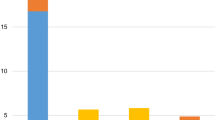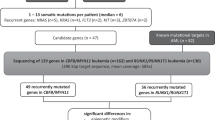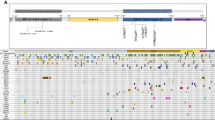Abstract
Point mutations of the transcription factor AML1 are associated with leukemogenesis in acute myeloblastic leukemia (AML). Internal tandem duplications (ITDs) in the juxtamembrane domain and mutations in the second tyrosine kinase domain of the Fms-like tyrosine kinase 3 (FLT3) gene represent the most frequent genetic alterations in AML. However, such mutations per se appear to be insufficient for leukemic transformation. To evaluate whether both AML1 and FLT3 mutations contribute to leukemogenesis, we analyzed mutations of these genes in AML M0 subtype in whom AML1 mutations were predominantly observed. Of 51 patients, eight showed a mutation in the Runt domain of the AML1 gene: one heterozygous missense mutation with normal function, five heterozygous frameshift mutations and two biallelic nonsense or frameshift mutations, resulting in haploinsufficiency or complete loss of the AML1 activities. On the other hand, a total of 10 of 49 patients examined had the FLT3 mutation. We detected the FLT3 mutation in five of eight (63%) patients with AML1 mutation, whereas five of 41 (12%) without AML1 mutation showed the FLT3 mutation (P=0.0055). These observations suggest that reduced AML1 activities predispose cells to the acquisition of the activating FLT3 mutation as a secondary event leading to full transformation in AML M0.
This is a preview of subscription content, access via your institution
Access options
Subscribe to this journal
Receive 12 print issues and online access
$259.00 per year
only $21.58 per issue
Buy this article
- Purchase on Springer Link
- Instant access to full article PDF
Prices may be subject to local taxes which are calculated during checkout




Similar content being viewed by others
References
Miyoshi H, Shimizu K, Kozu T, Maseki N, Kaneko Y, Ohki M . The t(8;21) breakpoints on chromosome 21 in acute myeloid leukemia clustered within a limited region of a novel gene, AML1. Proc Natl Acad Sci USA 1991; 88: 10431–10434.
Nucifora G, Rowley JD . AML1 and the 8;21 and 3;21 translocations in acute and chronic myeloid leukemia. Blood 1995; 86: 1–14.
Tenen DG, Hromas R, Licht JD, Zhang DE . Transcription factors, normal myeloid development, and leukemia. Blood 1997; 90: 489–519.
Speck NA, Gilliland DG . Core-binding factors in haematopoiesis and leukaemia. Nat Rev Cancer 2002; 2: 502–513.
Asou N . The role of a Runt domain transcription factor AML1/RUNX1 in leukemogenesis and its clinical implications. Crit Rev Oncol Hematol 2003; 45: 129–150.
Liu P, Tarle SA, Hajra A, Claxton DF, Marlton P, Freedman M et al. Fusion between transcriptional factor CBFβ/ PEBP2β and myosin heavy chain in acute myeloid leukemia. Science 1993; 261: 1041–1044.
Meyers S, Lenny N, Hiebert SW . The t(8;21) fusion protein interferes with AML-1b-dependent transcriptional activation. Mol Cell Biol 1995; 15: 1974–1982.
Hiebert SW, Sun W, Davis JN, Golub T, Shurtleff S, Buijs A et al. The t(12;21) translocation converts AML-1B from an activator to a repressor of transcription. Mol Cell Biol 1996; 16: 1349–1355.
Yergeau DA, Hetherington CJ, Wang Q, Zhang P, Sharpe AH, Binder M et al. Embryonic lethality and impairment of haematopoiesis in mice heterozygous for an AML1-ETO fusion gene. Nat Genet 1997; 15: 303–306.
Okuda T, Cai Z, Yang S, Lenny N, Lyu CJ, van Deursen JM et al. Expression of a knocked-in AML1-ETO leukemia gene inhibits the establishment of normal definitive hematopoiesis and directly generates dysplastic hematopoietic progenitors. Blood 1998; 91: 3134–3143.
Rhoades KL, Hetherington CJ, Harakawa N, Yergeau DA, Zhou L, Liu LQ et al. Analysis of the role of AML1-ETO in leukemogenesis, using an inducible transgenic mouse model. Blood 2000; 96: 2108–2115.
Castilla LH, Garrett L, Adya N, Orlic D, Dutra A, Anderson S et al. The fusion gene Cbfb-MYH11 blocks myeloid differentiation and predisposes mice to acute myelomonocytic leukaemia. Nat Genet 1999; 23: 144–146.
Yuan Y, Zhou L, Miyamoto T, Iwasaki H, Harakawa N, Hetherington CJ et al. AML1-ETO expression is directly involved in the development of acute myeloid leukemia in the presence of additional mutations. Proc Natl Acad Sci USA 2001; 98: 10398–10403.
Higuchi M, O'Brien D, Kumaravelu P, Lenny N, Yeoh EJ, Downing JR . Expression of a conditional AML1-ETO oncogene bypasses embryonic lethality and establishes a murine model of human t(8;21) acute myeloid leukemia. Cancer Cell 2002; 1: 63–74.
Tenen DG . Disruption of differentiation in human cancer: AML shows the way. Nat Rev Cancer 2003; 3: 89–101.
Osato M, Asou N, Abdalla E, Hoshino K, Yamasaki H, Okubo T et al. Biallelic and heterozygous point mutations in the runt domain of the AML1/PEBP2αB gene associated with myeloblastic leukemias. Blood 1999; 93: 1817–1824.
Preudhomme C, Warot-Loze D, Roumier C, Grardel-Duflos N, Garand R, Lai JL et al. High incidence of biallelic point mutations in the Runt domain of the AML1/PEBP2αB gene in M0 acute myeloid leukemia and in myeloid malignancies with acquired trisomy 21. Blood 2000; 96: 862–2869.
Song WJ, Sullivan MG, Legare RD, Hutchings S, Tan X, Kufrin D et al. Haploinsufficiency of CBFA2 causes familial thrombocytopenia with propensity to develop acute myelogenous leukaemia. Nat Genet 1999; 23: 166–175.
Michaud J, Wu F, Osato M, Cottles GM, Yanagida M, Asou N et al. In vitro analysis of known and novel RUNX1 mutations in dominant familial platelet disorder with predisposition to acute myelogenous leukemia (FPD/AML): implications for mechanisms of pathogenesis. Blood 2002; 99: 1364–1372.
Dowton SB, Beardsley D, Jamison D, Blattner S, Li FP . Studies of a familial platelet disorder. Blood 1985; 65: 557–563.
Osato M, Yanagida M, Shigesada K, Ito Y . Point mutations of the RUNX1/AML1 gene in sporadic and familial myeloid leukemias. Int J Hematol 2001; 74: 245–251.
Gilliland DG, Griffin JD . The roles of FLT3 in hematopoiesis and leukemia. Blood 2002; 100: 1532–1542.
Rosnet O, Schiff C, Pebusque M-J, Marchetto S, Tonnelle C, Toiron Y et al. Human FLT3/FLK2 gene: cDNA cloning and expression in hematopoietic cells. Blood 1993; 82: 1110–1119.
Levis M, Small D . FLT3:ITDoes matter in leukemia. Leukemia 2003; 17: 220–252.
Nakao M, Yokota S, Iwai T, Kaneko H, Horiike S, Kashima K et al. Internal tandem duplication of the flt3 gene found in acute myeloid leukemia. Leukemia 1996; 10: 1911–1918.
Kiyoi H, Naoe T, Nakano Y, Yokota S, Minami S, Miyawaki S et al. Prognostic implication of FLT3 and N-RAS gene mutations in acute myeloid leukemia. Blood 1999; 93: 3074–3080.
Yamamoto Y, Kiyoi H, Nakano Y, Suzuki R, Kodera Y, Miyawaki S et al. Activating mutation of D835 within the activation loop of FLT3 in human hematologic malignancies. Blood 2001; 97: 2434–2439.
Kottaridis PD, Gale RE, Frew ME, Harrison G, Langabeer SE, Belton AA et al. The presence of a FLT3 internal tandem duplication in patients with acute myeloid leukemia (AML) adds important prognostic information to cytogenetic risk group and response to the first cycle of chemotherapy: analysis of 854 patients from the United Kingdom Medical Research Council AML 10 and 12 trials. Blood 2001; 98: 1752–1759.
Schnittger S, Schoch C, Dugas M, Kern W, Staib P, Wuchter C et al. Analysis of FLT3 length mutations in 1003 patients with acute myeloid leukemia: correlation to cytogenetics, FAB subtype, and prognosis in the AMLCG study and usefulness as a marker for the detection of minimal residual disease. Blood 2002; 100: 59–66.
Thiede C, Steudel C, Mohr B, Schaich M, Schakel U, Platzbecker U et al. Analysis of FLT3-activating mutations in 979 patients with acute myelogenous leukemia: association with FAB subtypes and identification of subgroups with poor prognosis. Blood 2002; 99: 4326–4335.
Abu-Duhier FM, Goodeve AC, Wilson GA, Care RS, Peake IR, Reilly JT . Identification of novel FLT-3 Asp835 mutations in adult acute myeloid leukaemia. Br J Haematol 2001; 113: 983–988.
Bennett JM, Catovsky D, Daniel MT, Flandrin G, Galton DA, Gralnick HR et al. Proposal for the recognition of minimally differentiated acute myeloid leukaemia (AML-M0). Br J Haematol 1991; 78: 325–329.
Osato M, Asou N, Okubo T, Nishimura S, Yamasaki H, Era T et al. Myelomonoblastic leukaemia cells carrying a PEBP2β and MYH11 fusion gene are CD34+, c-KIT+ immature cells. Br J Haematol 1997; 97: 656–658.
Ohno R, Kobayashi T, Tanimoto M, Hiraoka A, Imai K, Asou N et al. Randomized study of individualized induction therapy with or without vincristine, and of maintenance-intensification therapy between 4 or 12 courses in adult acute myeloid leukemia. AML-87 study of the Japan Adult Leukemia Study Group. Cancer 1993; 71: 3888–3895.
Kobayashi T, Miyawaki S, Tanimoto M, Kuriyama K, Murakami H, Yoshida M et al. Randomized trials between behenoyl cytarabine (BHAC) and cytarabine in combination induction and consolidation therapy, and with or without ubenimex after maintenance/intensification therapy in adult acute myeloid leukemia. J Clin Oncol 1996; 14: 204–213.
Miyawaki S, Tanimoto M, Kobayashi T, Minami S, Tamura J, Omoto E et al. No beneficial effect from addition of etoposide to daunorubicin, cytarabine, and 6-mercaptopurine in individualized induction therapy of adult acute myeloid leukemia: JALSG-AML92 study. Int J Hematol 1999; 70: 97–104.
Hoshino K, Asou N, Okubo T, Suzushima H, Kiyokawa T, Kawano F et al. The absence of the p15INK4B gene alterations in adult patients with precursor B-cell acute lymphoblastic leukaemia is a favourable prognostic factor. Br J Haematol 2002; 117: 531–540.
Miyoshi H, Ohira M, Shimizu K, Mitani K, Hirai H, Imai T et al. Alternative splicing and genomic structure of the AML1 gene involved in acute myeloid leukemia. Nucleic Acid Res 1995; 23: 2762–2769.
Nishimura S, Asou N, Suzushima H, Okubo T, Fujimoto T, Osato M . p53 gene mutation and loss of heterozygosity are associated with increased risk of disease progression in adult T cell leukemia. Leukemia 1995; 9: 598–604.
Abu-Duhier FM, Goodeve AC, Wilson GA, Care RS, Peake IR, Reilly JT . Genomic structure of human FLT3: implications for mutational analysis. Br J Haematol 2001; 113: 1076–1089.
Rosnet O, Mattei MG, Marchetto S, Birnbaum D . Isolation and chromosomal localization of a novel FMS-like tyrosine kinase gene. Genomics 1991; 9: 380–385.
Langabeer SE, Gale RE, Rollinson SJ, Morgan GJ, Linch DC . Mutations of the AML1 gene in acute myeloid leukemia of FAB types M0 and M7. Genes Chromosomes Cancer 2001; 34: 24–32.
Roumier C, Eclache V, Imbert M, Davi F, MacIntyre E, Garand R et al. M0 AML, clinical and biological features of the disease including AML1 gene mutations: a report of 59 cases by the Groupe Francais d'Hematologie Cellulaire (GFHC) and the Groupe Francais de Cytogenetique Hematologique (GFCH). Blood 2003; 101: 1277–1283.
Miyamoto T, Nagafuji K, Akashi K, Harada M, Kyo T, Akashi T et al. Persistence of multipotent progenitors expressing AML1/ETO transcripts in long-term remission patients with t(8;21) acute myelogenous leukemia. Blood 1996; 87: 4789–4796.
Basecke J, Cepek L, Mannhalter C, Krauter J, Hildenhagen S, Brittinger G et al. Transcription of AML1/ETO in bone marrow and cord blood of individuals without acute myelogenous leukemia. Blood 2002; 100: 2267–2268.
Taketani T, Taki T, Takita J, Ono R, Horikoshi Y, Kaneko Y et al. Mutation of the AML1/RUNX1 gene in a transient myeloproliferative disorder patient with Down syndrome. Leukemia 2002; 16: 1866–1867.
Mueller BU, Pabst T, Osato M, Asou N, Johansen LM, Minden MD et al. Heterozygous PU.1 mutations are associated with acute myeloid leukemia. Blood 2002; 100: 998–1007.
Whitman SP, Archer KJ, Feng L, Baldus C, Becknell B, Carlson BD et al. Absence of the wild-type allele predicts poor prognosis in adult de novo acute myeloid leukemia with normal cytogenetics and the internal tandem duplication of FLT3: a cancer and leukemia group B study. Cancer Res 2001; 61: 7233–7239.
Kelly LM, Liu Q, Kutok JL, Williams IR, Boulton CL, Gilliland DG . FLT3 internal tandem duplication mutations associated with human acute myeloid leukemias induce myeloproliferative disease in a murine bone marrow transplant model. Blood 2002; 99: 310–318.
Nakano Y, Kiyoi H, Miyawaki S, Asou N, Ohno R, Saito H et al. Molecular evolution of acute myeloid leukaemia in relapse: unstable N-ras and FLT3 genes compared with p53 gene. Br J Haematol 1999; 104: 659–664.
Asou N, Suzushima H, Hattori T, Nishikawa K, Wang JX, Okubo T et al. Acute unclassified leukemia originating from undifferentiated cells with the aberrant rearrangement and expression of immunoglobulin and T-cell receptor genes. Leukemia 1991; 5: 293–299.
Bene MC, Bernier M, Casasnovas RO, Castoldi G, Doekharan D, van der Holt B et al. Acute myeloid leukaemia M0: haematological, immunophenotypic and cytogenetic characteristics and their prognostic significance: an analysis in 241 patients. Br J Haematol 2001; 113: 737–745.
Beghini A, Peterlongo P, Ripamonti CB, Larizza L, Cairoli R, Morra E et al. C-kit mutations in core binding factor leukemias. Blood 2000; 95: 726–727.
Kelly LM, Kutok JL, Williams IR, Boulton CL, Amaral SM, Curley DP et al. PML/RARalpha and FLT3-ITD induce an APL-like disease in a mouse model. Proc Natl Acad Sci USA 2002; 99: 8283–8288.
Acknowledgements
The authors are very grateful to Drs M Takeuchi, A Takeshita, K Kawakami, K Isogai and all contributors to this work for their kind help. We thank to Ms H Ogata for technical assistances. This work is supported in part by Grants-in-Aid for Scientific Research from the Japanese Ministry of Education, Science and Culture, Grants-in-Aid for Cancer Research from Japanese Ministry of Health and Welfare (No. 9-2).
Author information
Authors and Affiliations
Rights and permissions
About this article
Cite this article
Matsuno, N., Osato, M., Yamashita, N. et al. Dual mutations in the AML1 and FLT3 genes are associated with leukemogenesis in acute myeloblastic leukemia of the M0 subtype. Leukemia 17, 2492–2499 (2003). https://doi.org/10.1038/sj.leu.2403160
Received:
Accepted:
Published:
Issue Date:
DOI: https://doi.org/10.1038/sj.leu.2403160
Keywords
This article is cited by
-
RUNX1 mutation has no prognostic significance in paediatric AML: a retrospective study of the AML-BFM study group
Leukemia (2023)
-
The RUNX1–PU.1 axis in the control of hematopoiesis
International Journal of Hematology (2015)
-
Targeted next-generation sequencing detects point mutations, insertions, deletions and balanced chromosomal rearrangements as well as identifies novel leukemia-specific fusion genes in a single procedure
Leukemia (2011)
-
Hereditary thrombocytopenia and acute myeloid leukemia: a common link due to a germline mutation in the AML1 gene
Annals of Hematology (2009)
-
Possible involvement of RasGRP4 in leukemogenesis
International Journal of Hematology (2009)



